Making your blood glucose meter and continuous glucose monitor (CGM) work for you

When you use a blood glucose meter, it shows a real-time snapshot of your glucose levels. A continuous glucose monitor (CGM) is a little different. It shows the ups and downs in your glucose levels over time.
If you’re using both a blood glucose meter and a CGM, you may notice that your readings are not exactly the same. This is not only OK, it’s expected. Your blood glucose meter tells you where your glucose levels are now—in real time. Your CGM can look back and give you an overview of where your glucose levels have been.
The reason for this difference is in how blood glucose meters and CGMs measure glucose levels:
Blood glucose meters measure the amount of glucose in your blood.
CGMs measure interstitial glucose, which is the glucose in the fluid just under your skin.
Lag time
When your glucose levels change, it’s reflected in your blood immediately. The fluid under your skin reflects the change 5 to 20 minutes later. This difference is sometimes called lag time.
Here’s how lag time works. Imagine a long train with several cars moving up and down on a hilly track. The number you see on the blood glucose meter reflects the first car of the train. It is the first part of the train to move up and down. The number reflected by the CGM is like the caboose of the train. It moves up and down a bit later.
If there are no recent changes in your glucose levels, both the CGM and the blood glucose meter readings will look similar. But if your glucose levels have recently increased or decreased, they will be reflected by the blood glucose meter—that first car—faster.
Even if you mostly rely on your CGM, there are times when you’ll need to consult your blood glucose meter. Here are some examples:
Your CGM doesn’t show both an arrow and a number after the warm-up period. This may happen when the sensor isn’t collecting an accurate reading.
Your readings look OK, but you don’t feel right. If the meter reading matches your symptoms, treat them—and later, calibrate your CGM to make sure it aligns with the meter.
You get a “signal loss alert.” This error message on your app or receiver means the CGM isn’t working, or your phone or reader is too far away for Bluetooth signals to be received. You won’t get alerts, alarms or readings.
You’ve started using a new sensor. There is a 2-hour warm-up period where your CGM won’t show any readings.
Together, your blood glucose meter and CGM can make sure you’re covered at all times and give you a more complete understanding of your glucose levels. Talk to a coach to help you better understand how these numbers can complement each other.
CLC016410.A
Was this article helpful?
Sign up to unlock your health, your way at no cost to you.
This content is not intended to be a substitute for professional medical advice, diagnosis or treatment. Always seek the advice of your physician or other qualified health provider with any questions you may have regarding a medical condition.
